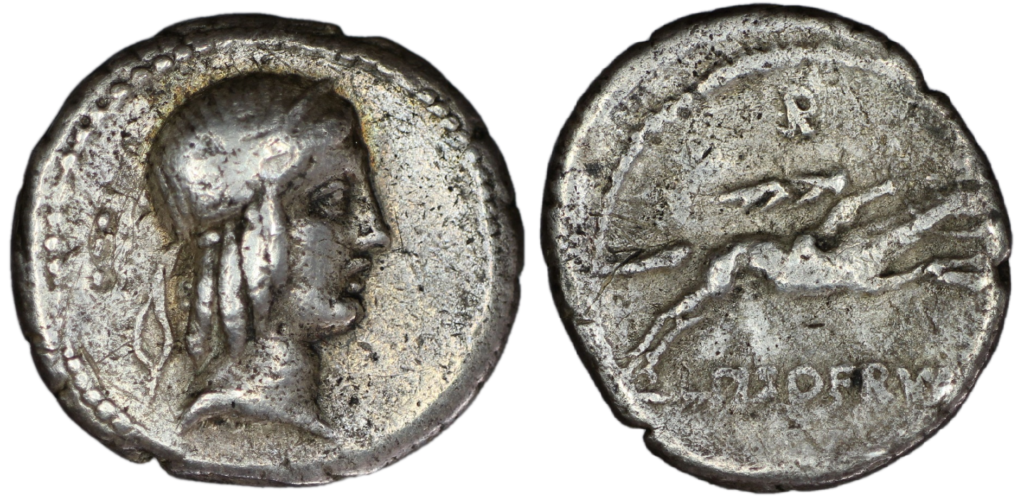
If I were a proper numismatist, I’d probably see this coin and see a rather common type, in not especially stellar condition. These coins – despite being ancient artefacts, and unique opportunities to interact with tangible antiquity – exist in huge numbers. So many were churned out in production that to keep track of all those dies and to keep the workers honest, a vast, sprawling system of control marks was included in the design, which exist separately from the world of the image. (This is not immediately obvious: I once saw someone be very embarrassed at a conference when their neat interpretation of a comet was, it was pointed out, based on imagining the star control mark was part of the design).
On this coin those control marks take the form of three pellets or dots behind Apollo (⋮), and an R above the horseman. Far more interesting control marks exist in terms of their visual interest. But I can’t really get excited about these. For me, the main design is far more interesting.
Firstly, that hairstyle. It’s… a strong look. The wreath, appropriate to Apollo, is tightly tied behind his head (tassels hang behind in a loop) and the hair on his crown tightly held down in neatly combed and rather regimented rows. Hair, when neatly coiffed, shows leisure time and wealth for humans, as they can afford to spend time and money getting it just so, but of course for a god such neat hair reflects Apollo’s beauty, and his somewhat effete nature. Cascading down past the tie are very thick and somewhat heavy looking corkscrew curls. When die cutters cast around for a model to emulate, they did not simply make up an Apollo according to how they felt he should look. To a greater or lesser extent they modelled their deities on well-known representational types. We tend to be able to group even full-scale marble statues into various different types according to which famous original archetype they emulate. (100 years ago they would have seen deviations from the archetype as aberrations, but now we tend to see them as having contemporary significance).

The Apollo we see in these coins looks, to my mind, most like a particular “type” called the Mantua Apollo. There are similarities with other Apollos, and a bronze Apollo Citharoedus from the Casa del Citarista has very similar hair, but the Mantua Apollo is a very famous type so is a good candidate for an iconographic model. The same neat hair on top, tight wreath, and tumbling curling locks are in both. The version in marble above was made in roughly the same time period as our coin, so it indicates a contemporary popularity of the type. The corkscrew curls are a little more free in the marble, and a little lighter looking, but I think it is a definite possibility that the origins of the statue and the coin image go back to the same model – which in the case of the Apollo of Mantua type, is a lost bronze original by Polykleitos, the Greek master sculptor.

Above we see the same type of hairstyle in an earlier limestone head of Apollo, itself alluding to a famous archetype (probably also the Polykleitan original). Here the locks are more tightly curled and shorter, a little more like the hairstyle of Apollo from the coin. The statue below, which stems from a different archetype, shows how these reproductions are still fashionable today, albeit at the expense of precision manufacture.

The other thing that interests me about this coin is the depiction of the horse and rider on the reverse. They are depicted at full gallop, but the jockey holds the palm branch of victory, eliding the moment of victory and the event leading up to it in a typically Roman manner. The horse is fully stretched out, in the posture that was commonly depicted in art up until Muybridge showed that horses did not move this way – not, really, that naturalism should matter so much. The reverse is a vivid evocation of extreme exertion. The horse is slender and lean, his neck exaggerated in its extension, his flanks tucked in, his tail streaming out at 90 degrees. His rider leans forward in the attitude of a jockey, and the overall suggestion is of a horse and rider racing; military overtones are entirely lacking.
The link between the obverse is based on the family’s claim to have been instrumental in the founding of the ludi Apollinares, at which games horseracing was a popular part. These games, founded over a century prior, enabled the moneyer to claim descent from an important and influential family. The choice of a venerable old Apollo type therefore supports their claim to longevity and ancestral importance. The dynamism of the reverse, where the streaming tail and palm branch, straining horse and horizontal rushing motion, highlight how the games-and-family are still exciting and important.